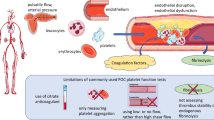Abstract
Principally, there are two reasons why the pharmacological response to antiplatelet drugs should be measured: on the one hand, an insufficient inhibition of platelet function may result in atherothrombotic complications; on the other hand, an excessive inhibition of platelet function may lead to bleeding complications. The clinical importance to measure the effects of antiplatelet drugs is demonstrated by increasingly growing evidence for an association of resistance to antiplatelet drugs with thromboembolic events. It is often claimed that there is no generally accepted definition of “resistance” and, instead, there is an ongoing semantic discussion about the correct term to be used to describe this phenomenon. From the pharmacological point of view, there is only one acceptable definition of “resistance” to antiplatelet drugs: the term “resistance” should be used when a drug is unable to hit its pharmacological target. Thus, laboratory methods used to evaluate the effects of antiplatelet drugs should be designed to measure the direct pharmacodynamic effect of a drug, rather than the consequences for global platelet function. Based on physiological/pathophysiological, pharmacological, and practical considerations, the authors propose the following assays to be used to measure the effects of oral antiplatelet drugs: for the detection of aspirin actions, thromboxane or arachidonic acid-induced responses (light aggregometry, whole-blood aggregometry) should be measured; for the detection of clopidogrel actions, VASP (vasodilator-stimulated phosphoprotein) phosphorylation (flow cytometry) or ADP-(adenosine diphosphate-)induced responses (light aggregometry, whole-blood aggregometry, possibly also flow cytometry) should be measured.
Zusammenfassung
Es gibt zwei prinzipielle Gründe für die Messung der pharmakologischen Wirksamkeit von Thrombozytenfunktionshemmern: Auf der einen Seite kann eine unzureichende Hemmung der Thrombozytenfunktion zu atherothrombotischen Komplikationen führen; auf der anderen Seite kann eine exzessive Hemmung der Thrombozytenfunktion in Blutungskomplikationen resultieren. Die klinische Bedeutung der Messung der Wirkungen von Thrombozytenfunktionshemmern zeigt sich in einer zunehmenden Evidenz für die Assoziation einer fehlenden pharmakologischen Wirksamkeit mit thromboembolischen Ereignissen. Es wird häufig postuliert, dass es keine allgemein akzeptierte Definition für „Resistenz““ gegenüber Thrombozytenfunktionshemmern gibt. Stattdessen wird eine semantische Diskussion über den korrekten Begriff zur Beschreibung des Phänomens geführt. Aus pharmakologischer Sicht gibt es jedoch eine klare Definition der Resistenz gegenüber Thrombozytenfunktionshemmern: Der Begriff „Resistenz“ sollte benutzt werden, wenn ein Pharmakon den für die klinische Wirksamkeit entscheidenden pharmakodynamischen Mechanismus nicht ausüben kann. Daher sollten bevorzugt solche Labormethoden eingesetzt werden, die möglichst direkt den pharmakodynamischen Effekt eines Pharmakons erfassen. Basierend auf physiologischen/pathophysiologischen, pharmakologischen und praktischen Überlegungen wird vorgeschlagen, dass zur Erfassung der Wirkungen von Acetylsalicylsäure die Thromboxanbildung oder die arachidonsäureinduzierte Thrombozytenaggregation (Lichtaggregometrie, Vollblutaggregometrie) bestimmt werden sollte. Zur Erfassung der Wirkungen von Clopidogrel erscheint die Bestimmung der VASP-(„vasodilator-stimulated phosphoprotein“-)Phosphorylierung (Durchflusszytometrie) oder die ADP-(Adenosindiphosphat-) induzierte Thrombozytenaggregation (Lichtaggregometrie, Vollblutaggregometrie) bzw. Thrombozytenaktivierung (Durchflusszytometrie) sinnvoll.
Similar content being viewed by others
Author information
Authors and Affiliations
Consortia
Corresponding author
Rights and permissions
About this article
Cite this article
Weber, AA., Adamzik, M., Bachmann, H.S. et al. Methods to Evaluate the Pharmacology of Oral Antiplatelet Drugs. Herz 33, 287–296 (2008). https://doi.org/10.1007/s00059-008-3132-2
Issue Date:
DOI: https://doi.org/10.1007/s00059-008-3132-2




